Introduction to Viruses and the Immune System Response
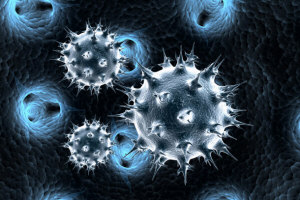 The word virus ignites fear in many people’s minds; they are capable of
inflicting extensive cell damage, can tolerate extreme temperatures and much
like an unwanted house guest, are very resistant to leaving the body. Viral
infections can range from being a minor inconvenience to a potentially life
threatening disaster. They are able to infect most living cells – belonging to
animals, plants or bacteria. The virus has one aim; to invade. The battle
between the virus and the immune system on a molecular level is often
overlooked, and although very complex – it is a fascinating world. The word virus ignites fear in many people’s minds; they are capable of
inflicting extensive cell damage, can tolerate extreme temperatures and much
like an unwanted house guest, are very resistant to leaving the body. Viral
infections can range from being a minor inconvenience to a potentially life
threatening disaster. They are able to infect most living cells – belonging to
animals, plants or bacteria. The virus has one aim; to invade. The battle
between the virus and the immune system on a molecular level is often
overlooked, and although very complex – it is a fascinating world.
An Introduction to Viruses
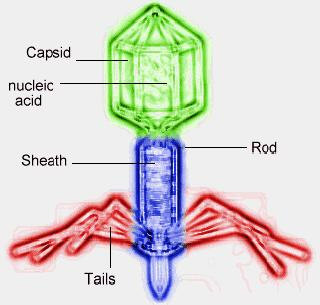 Only able to perform any metabolic activity inside living host cells, a virus
cannot multiply unless in these conditions. It is for this reason that it is
highly debated whether viruses should be considered ‘living’ or not. Viruses are
microbes, consisting of only a nucleic acid core (DNA or RNA) surrounded by a
protein coat known as a capsid. Viruses are the smallest known microbe, although
sizes can vary drastically. A singular virus particle is known as a virion. They
are generally between 10nm to 300nm, compared to the approximate size of
bacteria being 1000nm. The protein coat surrounding the virus serves as a
protective barrier of the genetic material, ensuring that it is safe from
inactivation as a result of environmental factors. The capsid is composed of
structural protein units known as capsomeres. Only able to perform any metabolic activity inside living host cells, a virus
cannot multiply unless in these conditions. It is for this reason that it is
highly debated whether viruses should be considered ‘living’ or not. Viruses are
microbes, consisting of only a nucleic acid core (DNA or RNA) surrounded by a
protein coat known as a capsid. Viruses are the smallest known microbe, although
sizes can vary drastically. A singular virus particle is known as a virion. They
are generally between 10nm to 300nm, compared to the approximate size of
bacteria being 1000nm. The protein coat surrounding the virus serves as a
protective barrier of the genetic material, ensuring that it is safe from
inactivation as a result of environmental factors. The capsid is composed of
structural protein units known as capsomeres.
Many virus particles (though not
all) are also surrounded by an envelope composed of lipoprotein, containing
viral antigens. An antigen is a foreign substance that is often toxic in nature,
promoting antibody production in the blood. In the event of a virus finding a
suitable cell and deciding to replicate itself, it essentially ‘reprograms’ the
cells synthesizing apparatus to instead produce virus components. It does this
by transcription of the core nucleic acid into mRNA, which is virus specific
messenger. This directs the cell to carry out the process of replicating the
virus. The virus essentially takes hostage of the cell.
Anatomy of a Virus:
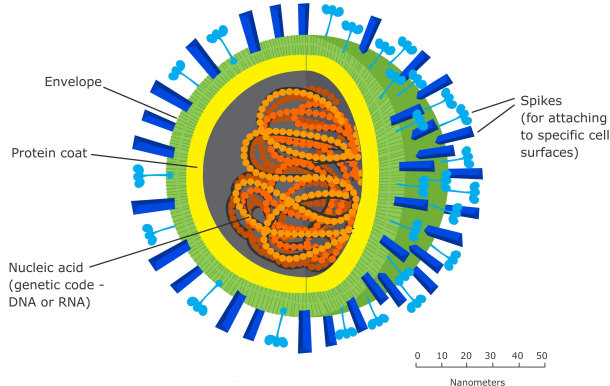
There are four primary
ways that a virus can affect a cell; death, transformation, latent infection and haemadsorption. Transformation, as the name suggests, changes the properties of
the cell from normal to potentially cancerous or malignant. Latent infection
means that though the virus is within a cell, there are no clearly noticeable
effects on the cells activities and functions. Haemadsorption occurs when the
outer protein coat of the virus adheres to erythrocytes (red blood cells),
resulting in them clumping together.
An Introduction to the Immune System
|
Single Human Lymphocyte:
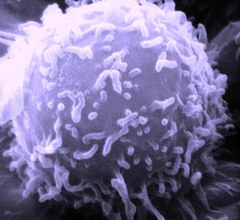
|
To first understand how the immune system combats viral infection, it is
essential to understand the basic function and components. The function of the
complex immune system is to defend the body from potentially harmful invaders.
An invader may be in the form of a bacterial, fungal, viral or parasitic
infection. There are several well equipped components involved that are
continually working together to eliminate the unwanted guest(s). Lymphocytes are
a type of white blood cell that are heavily involved in immune system function,
and a main component of adaptive immunity. This is when the Immune system adapts
and evolves to become better equipped to defend itself against specific
attackers. The main function of lymphocytes is to provide immune defense against
invaders which they are specifically programmed to respond to.
How it Works
Despite what the name suggests, the immune system is rather more
like a scattering of organs and tissue throughout the body – it is not contained
to one area. Lymphocytes are present in the adenoids, tonsils, thymus, lymph
nodes, spleen, appendix, lymphatic vessels and bone marrow. The origin of all
the immune systems cells is the bone marrow, where some stem cells develop
further into more specialized cells through a process called haematopoiesis.
Click to Enlarge - Haematopoiesis in Humans
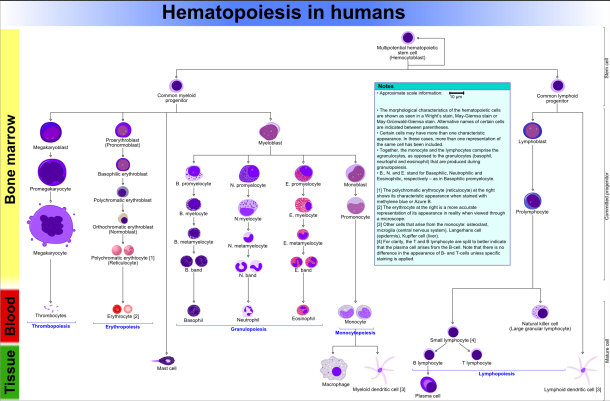
It
is here that the cells ‘branch off’ into separate groups with different tasks
within the immune system. Cells may develop into the aforementioned lymphocytes,
or phagocytes, which are able to consume microorganisms. Lymphocyte cells are
then separated again to become either B lymphocytes (which mature in the
original bone marrow) or T lymphocytes, which travel to the Thymus before
developing further. There is especially a heavy concentration of B and T cells
in the spleen and lymph nodes. B cells are able to produce antibodies whereas T
cells cannot; they instead directly attack their target. Both T and B cells
possess receptors which respond only to specific antigen molecules, increasing
their ability to successfully eliminate infection. B cells specifically operate
by binding their antibodies to specific antigens, in order to effectively
‘neutralize’ their harmful effects.
Antibodies are able to attack or order other cells to attack on their behalf.
When T cells have traveled to the thymus for maturity, they undergo a process
which enables them to distinguish cells from the body they live in (self-cells)
apart from potential invaders (nonself cells). During this time the T cells
become one of several types, each with their own specialty and functions. There
are memory T cells, helper T cells, regulatory T cells, suppressor T cells and
cytotoxic T cells (otherwise known as natural killer cells). If a cell is
destined to become a phagocyte instead, it will aid the immune system by
consuming the target microorganism or virus, resulting in destruction of it
entirely. Some examples include neutrophils, eosinophils, and macrophages.
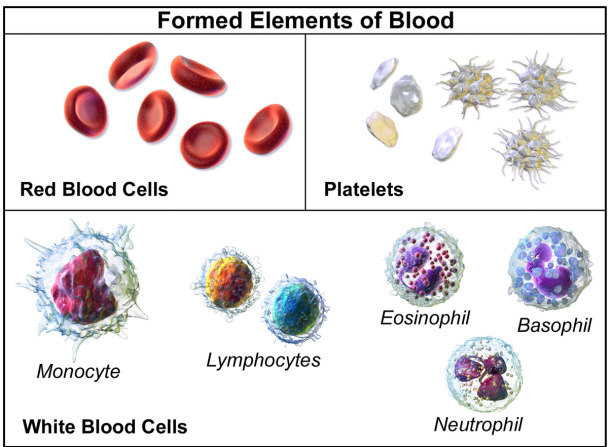
By BruceBlaus
via Wikimedia Commons
Phagocytes are white blood cells that ingest microorganisms, and so have a very
important role in the immune systems constant fight for health. Neutrophils are
the main component of pus, and they completely engulf and dispose of invading
organisms through a process known as phagocytosis. Eosinophils are primarily
involved in the host defense against parasites, whereas macrophages play a
similar role to neutrophils but are more specialized in chronic inflammation.
The aforementioned examples are all involved in the inflammatory response; this
is when your immune system responds to wounds by sending phagocytes to the
inflamed area to ingest the offending bacteria. This is an example of a
non-specific immune response. The inflammatory response does not target specific
invaders, but is part of the skins role as a ‘barrier’ in the immune system.
This makes up some of the innate immune system; including skin and mucous
membranes, nasal secretions and cilia present on the upper respiratory tract
cells to defer bacteria. It is the first nonspecific line of defense to
invasion. When this defense fails, other immune responses are activated.
Immune Response to Viral Infection
The other branch of immune response is known as adaptive immunity; this
responds to specific invaders such as viruses. It is composed mainly of B and T
cells, discussed previously in the introduction to the immune system. This type
of response is separated again into two areas; B cells participate in what’s
known as the humoral immune response, and T cells participate in cell mediated
immune response. Humoral immunity is the principle defense mechanism against
invading microbes and involves antibodies, produced by B cells and circulated to
effectively disable the virus before it can enter and cause irreparable damage
to cells.
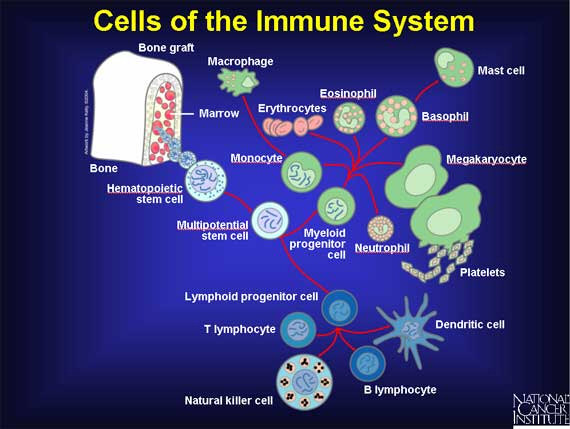
The antibodies are able to attach themselves to the virus and remove
it from the body, as well as using various effector mechanisms to eliminate
them. They are specialized by function, and so some antibodies specialize in
phagocytic processes such as the ingestion of viruses, while others may trigger
the inflammatory response in cells.
How the Cells Defend
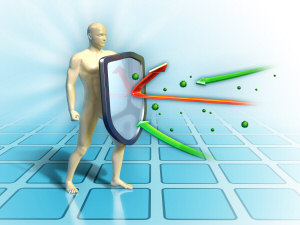 Cell mediated response is more specific, and involves T
cells directly attacking the virus. Some viruses are able to use phagocytes as
host cells, and so circulating antibodies cannot attach themselves to or
eliminate them. This is where cell mediated immunity is important; it is able to
destroy even viruses residing in other cells. The infected cell is destroyed
entirely, by 3 subgroups of T cells consisting of helper T cells, suppressor T
cells and cytotoxic T cells. Cytotoxic T cells are cells that attack viruses
expressing abnormal antigens and produce lymphokines, which are proteins that
promote the inflammatory response. The adaptive immune system is extremely
efficient and selects the most useful cells to deal with different types of
invasions. Antibodies are also made in this type of immune response, binding
themselves to the virus in order to disable them, stop them from further
invading any host cells and promote their ingestion through phagocytosis. The
virus is essentially destroyed and entirely removed from the body during this
process. Cell mediated response is more specific, and involves T
cells directly attacking the virus. Some viruses are able to use phagocytes as
host cells, and so circulating antibodies cannot attach themselves to or
eliminate them. This is where cell mediated immunity is important; it is able to
destroy even viruses residing in other cells. The infected cell is destroyed
entirely, by 3 subgroups of T cells consisting of helper T cells, suppressor T
cells and cytotoxic T cells. Cytotoxic T cells are cells that attack viruses
expressing abnormal antigens and produce lymphokines, which are proteins that
promote the inflammatory response. The adaptive immune system is extremely
efficient and selects the most useful cells to deal with different types of
invasions. Antibodies are also made in this type of immune response, binding
themselves to the virus in order to disable them, stop them from further
invading any host cells and promote their ingestion through phagocytosis. The
virus is essentially destroyed and entirely removed from the body during this
process.
Conclusion
The current modern research into viral infection has proved
immensely useful to both scientists and the pharmaceutical industry.
Understanding how exactly these microbes can invade is the key to prevention; it
is an area of study that is hugely important. Though there are still gray areas
of the immune system that need to be explored, modern findings are getting
closer and closer to discovering how to cure viral infection through studying
the microbiology of viruses and immune system response.
General
15 Interesting Things You Should Know About Stephen Hawking
8 Theories that Explain the Bermuda Triangle Mystery
The Hadron Collider
Introduction to Viruses and the Immune System Response |